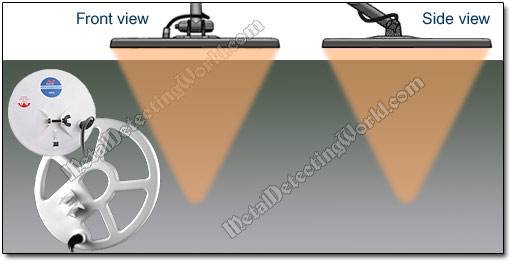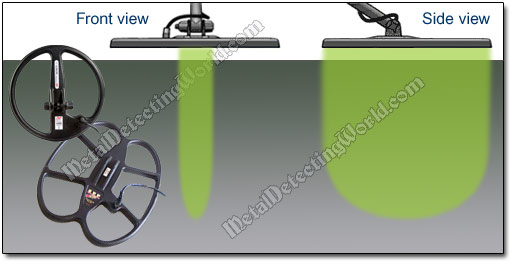Metal Detector's Depth Penetration, page 2
How To Avoid Reduction of Detector's Operational Depth Range Under Real Conditions
(...CONTINUED from Previous Page)
4) Wrong size of a search coil may greatly reduce your detector's ability to sense deep targets. Because of a shape (pattern) of the electromagnetic field transmitted by the search coil down into the ground, this electromagnetic field "encompasses" a certain volume of dirt. For example, the pattern of an 11-inch searchcoil's electromagnetic field looks like a cone and encompasses a few gallons volume of dirt including all its mineral content.
Electromagnetic Field Pattern of Concentric Search Coils

The larger the search coil, the more mineralization is "grabbed" by the detector's receive coil, the harder for the detector's circuitry to "see" the target among the "digested" noise, i.e. to separate the target's induced electromagnetic field from the excessive ground mineral interference. To reduce negative effects of the high-mineralized soil on your detector's depth penetration, you should use a smaller search coil. For example, the ground mineral effect can be reduced by several times if you replace the 11-inch search coil with an 8-inch coil that "sees" only one gallon volume of dirt.
Also, the search coil type can make a big difference. For instance, an 11" Double-D (DD) search coil has an advantage over the 8" Concentric coil because the Double-D coil still "sees" less gallons volume of dirt than the 8" coil due to the shape of the Double-D coil's electromagnetic field - a narrow "blade" (see a picture below). This design gets less of the ground-mineral effect while covering more ground in one sweep.
Electromagnetic Field Pattern of Double-D Search Coils

The Double-D search coils are now the standard coils on today's most metal detectors for their superior depth penetrating and ground balancing abilities even in the most adverse ground conditions, to say nothing of their superior target separating ability in high trash areas.
A large concentric search coil might have a huge negative effect on the machine's Detecting Range: the scan-area of the coil can become a problem in trashy areas where the search coil detects both rejected and accepted targets simultaneously, thus, not "seeing" the good targets masked by junk (see details below). Only selecting a large search coil of the DD type and increasing the detector's Recovery Speed (Reactivity) can solve this problem.
The larger the search coil, the larger the volume of transmitted electromagnetic field. Although the large search coils provide greater Operating Depth Range and ground coverage than small coils, the small coils have a greater advantage over the large coils in terms of Depth Penetration and target separation under adverse metal detecting conditions. To learn what criteria to use when choosing a proper size of your search coil for your current detecting task, please read the "Search Coil Selection" chapter on this page: "Metal Detecting Around Cellar Holes, page 2"